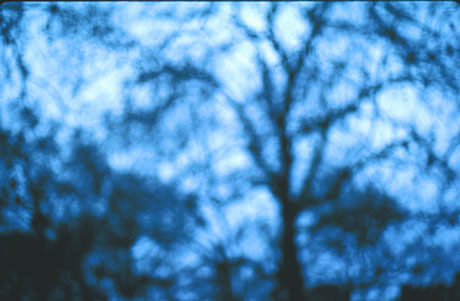Few of David Armstrong’s photographs rise above their overused conception
Both sides of the gallery’s center wall were covered by loads of photos of guys and choice vacation spots in all manner of framed, unframed, color and black and white prints, pinned up, loosely and overlapping, salon style. This tack board method of displaying 76 images doesn’t really help a lot of the obviously weak work.
However, there are some gems among the dross, including “James, Bovina, 2000”––a shirtless, backlit fellow emerging from a bathroom––and “Fernandez, Hotel Sherman, New York City, 2002”––a shirtless boy turning away from the camera and into the light and soft focus. The line of his backside, set against the window frame, is sharp and delectable.
Armstrong’s seven large sort-of-studio portraits on the back wall of the gallery ring rather hollow and limp for all the flesh and bedside scenes on display. This demimonde, A&F team of skinny 20-year-olds either stare off into the void or present bland canned faces––this is my “sensual look,” this is my “lost boy look”––without any narrative implication. Frustratingly held at arms’ length, you never really get a whiff of these boys––pretty and scruffy, yes––but there isn’t really a compelling beauty in either the composition or the models themselves. I’m just guessing, but I bet Armstrong didn’t get anything off these guys either.
Blur disease––it’s a terrible thing and David Armstrong has it on full display in the 20 large-format city views and landscapes that make up the balance of the show. The use of a soft or purposely out of focus imagery was a fresh concept put to moving aesthetic and conceptual use when photographers like Uta Bart and Bill Jacobson began exploring it a decade ago. Now it verges on being as overworked and overused an element as the slacker look of Armstrong’s models.
Far too many are like “Building, 10th Avenue,” where the shot of a New York City apartment building reads like a tourist snap and the blur comes off as an unfortunate mistake or a misapplied technique, not as a purposeful, let alone unique vision. Among the precious few standouts in this group of work is “Grosvenor Square, London,” a purplish, inky-blue abstraction. This smear of an image has a real visual pulse that transforms an everyday view of the boughs of a tree into something otherworldly. Also stepping forward is the distinctive “Tree in Autumn, Duxbury”––where the soft-focus adds a layer of complexity to a visually rich and completely compelling photograph.
We also publish:

































